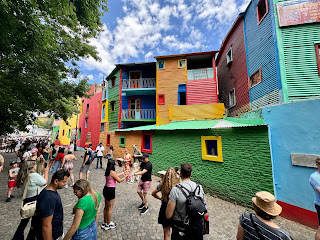La Boca:
Our first neighborhood was La Boca which is well south of the Microcentro. It is a little rough around the edges and very much a working-class neighborhood. It's also home to the Boca Juniors soccer team, the most famous in Argentina. Diego Maradona, an Argentine icon and one of the greatest footballers of all time, played for Boca. So did Lionel Messi, who wears the same number 10 as Maradona and just led Argentina to a World Cup victory. Murals, pictures, and advertisements of Messi were ubiquitous in every neighborhood we visited.
The highlight in La Boca was visiting Caminito. Caminito inspired the famous tango of the same name, and it is now a bustling street museum with brightly colored buildings. There was a large crowd as tourists mingled with locals. Streets were filled numerous art stalls, restaurants, and shops along with occasional street musicians. A very colorful neighborhood, both literally and figuratively.
Plaza de Mayo:
 |
| Casa Rosada |
 |
| Cabildo |
 |
| Metropolitan Cathedral |
 |
| Metropolitan Cathedral |
Puerto Madero:
Puerto Madero is the old dockside area that no longer sees shipping and cargo. Instead, its old warehouses have been transformed into a lively corridor of restaurants and shops with a vibrant social scene. This neighborhood definitely skews younger, with a lot of 20- and 30-somethings out for drinks and dinner.
Another more recent icon of Buenos Aires is here, the Puente de la Mujer (Woman's Bridge). It was designed by famed Spanish architect and sculptor Santiago Calatrava and it has been deemed part of the the city's cultural heritage by the Buenos Aires legislature. The bridge decking is plastic "wood" made from 100,000 recycled single use plastic bottles.
Palermo
We finished our day in the Palermo neighborhood, the largest in the City. There are actually several sub-neighborhoods within Palermo such as Palermo Chico, Palermo Soho, etc. We visited Plaza Serrano and the streets surrounding it which is in the heart of Palermo Soho. There were craft stalls in the square selling jewelry and other items, and the surrounding streets were filled with shops and restaurants. Palermo is generally known for being a little more upscale with its tree-lined streets and this part was no exception. We ate dinner at one of the local craft breweries near the square and soaked in the atmosphere with all of the young locals out and about on a Friday night.
While we barely scratched the surface, our day did give us a good feel for Buenos Aires and its neighborhoods. We look forward to returning and exploring more in depth.




No comments:
Post a Comment